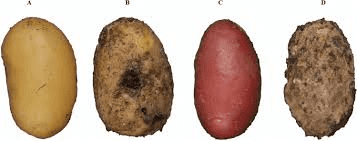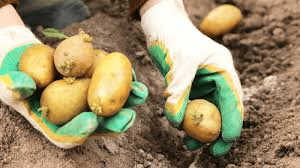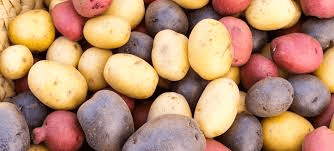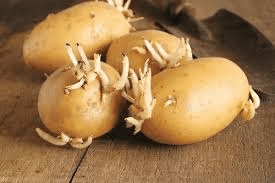Potato tubers, the edible part of the potato plant (Solanum tuberosum), are a staple food source worldwide, renowned for their nutritional value and versatility in cooking. These tubers are swollen, underground stems that store nutrients and energy for the plant. They are rich in carbohydrates, primarily in the form of starch, and also contain significant amounts of vitamins, minerals, and dietary fiber.
Potato plants belong to the Solanaceae family, which also includes tomatoes, eggplants, and peppers. The tubers develop from underground stems known as stolons. As the potato plant grows, these stolons extend into the soil, and the tips of the stolons swell to form tubers. This process is influenced by several factors, including soil temperature, moisture levels, and day length.
The outer layer of a potato tuber is called the periderm, which is a protective skin that helps reduce water loss and protect against pathogens. This skin can be smooth or rough, and its color varies from white to brown, red, or purple, depending on the potato variety. Beneath the periderm is the cortex, a layer of parenchyma cells that store starch. The majority of the tuber’s volume consists of the pith, which is the central region and also contains parenchyma cells filled with starch granules.
Potato tubers are a rich source of carbohydrates, making them an excellent energy source. They contain about 17% carbohydrates, primarily in the form of starch, which is composed of amylose and amylopectin. Starch granules in potatoes vary in size and shape, influencing the texture and culinary properties of different potato varieties. Potatoes also contain smaller amounts of proteins, vitamins, and minerals. They are particularly high in vitamin C, potassium, and vitamin B6. The dietary fiber in potatoes contributes to digestive health, while their antioxidants, including phenolic compounds and carotenoids, help combat oxidative stress.
The nutritional composition of potato tubers can vary depending on the variety and growing conditions. For example, different varieties may have different levels of specific nutrients, skin color, and flesh texture. Environmental factors such as soil quality, irrigation, and fertilization practices also influence the nutritional profile of potatoes.
Potato tubers are propagated vegetatively, meaning new plants are grown from sections of existing tubers rather than from seeds. Each tuber contains several “eyes,” which are dormant buds that can sprout and develop into new plants. When conditions are favorable, such as appropriate soil temperature and moisture, these eyes sprout and produce shoots that emerge above the soil surface. The shoots develop into new potato plants, which will eventually produce their own tubers.
Potatoes are susceptible to various pests and diseases, which can significantly impact crop yield and quality. Common potato pests include the Colorado potato beetle, aphids, and wireworms. Diseases such as late blight, caused by the oomycete Phytophthora infestans, can devastate potato crops if not properly managed. Integrated pest management strategies, crop rotation, and the use of resistant varieties are essential for sustainable potato production.
In addition to their role as a food source, potato tubers have several industrial applications. Potato starch is used in the food industry as a thickener, stabilizer, and gelling agent. It is also used in the production of biodegradable plastics, adhesives, and textiles. Moreover, potatoes are being explored as a source of bioethanol, a renewable energy source.
In conclusion, potato tubers are a vital agricultural product with significant nutritional, economic, and industrial importance. Their ability to grow in diverse climates and soil conditions, coupled with their rich nutrient content, makes them a staple food for millions of people worldwide. Advances in agricultural practices and pest management continue to enhance the productivity and sustainability of potato farming, ensuring this versatile crop remains a cornerstone of global food security.
The Economic Importance and Uses of Potato Tubers

1. Food Staple: Potato tubers are a primary food source worldwide, providing essential nutrients and energy. For example, in countries like Peru and Ireland, potatoes are a major part of the diet.
2. Animal Feed: Potato tubers are used as feed for livestock. They are rich in carbohydrates and can be processed into silage or fed directly to animals.
3. Industrial Raw Material: Potatoes are used in industries to produce starch, which is an important ingredient in the food, textile, and paper industries.
4. Alcohol Production: Potatoes can be fermented to produce alcoholic beverages like vodka. In Russia and Poland, potato-based vodka is quite popular.
5. Biofuel: Potato tubers can be used to produce bioethanol, a renewable energy source. This is particularly relevant in regions looking to reduce fossil fuel dependency.
6. Pharmaceutical Industry: Potato starch is used in the pharmaceutical industry as a binder in tablets and as a component in some medicinal formulations.
7. Food Processing: Potatoes are processed into various products like chips, fries, and instant mashed potatoes, creating significant economic value.
8. Export Commodity: Countries like the Netherlands and Germany export large quantities of potatoes and potato products, contributing to their economies.
9. Seed Production: Potato tubers are used to produce seed potatoes, which are vital for growing new crops.
10. Snack Production: The production of snacks like potato chips and crisps provides employment and economic activity in the food sector.
11. Soil Improvement: Potato cultivation can improve soil structure and fertility through crop rotation practices.
12. Biodegradable Packaging: Potato starch is used to make biodegradable plastics, which are environmentally friendly alternatives to conventional plastics.
13. Food Security: Potatoes are resilient crops that can grow in diverse climates, contributing to global food security.
14. Culinary Uses: Potatoes are used in various cuisines worldwide, making them a versatile ingredient in dishes like stews, soups, and casseroles.
15. Dietary Fiber: Potato tubers are a source of dietary fiber, which is essential for digestive health.
16. Economic Livelihood: Potato farming provides livelihoods for millions of farmers globally, particularly in developing countries.
17. Research and Development: Potatoes are used in scientific research for developing new crop varieties and studying plant diseases.
18. Culinary Innovation: Chefs and food innovators use potatoes to create new dishes and food products, adding to the culinary diversity and economic value.
Read Also: Importance of a Sick Bay in a Ruminant House
The Products and By-products That Can Be Derived From Potato Tubers

1. Potato Flour: Made by drying and grinding potatoes, used in baking and as a thickener.
2. Potato Starch: Extracted from potatoes and used in food products, textiles, and pharmaceuticals.
3. Potato Chips: Thinly sliced and fried potato snacks popular worldwide.
4. French Fries: Sliced potatoes fried and often served as a fast food item.
5. Instant Mashed Potatoes: Dehydrated potato flakes reconstituted with water or milk.
6. Potato Alcohol: Fermented and distilled to produce beverages like vodka.
7. Potato Dextrin: Used in adhesives, coatings, and as a food additive.
8. Potato Flakes: Dehydrated potato pieces used in processed foods and snacks.
9. Potato Granules: A form of dehydrated potato used in instant food products.
10. Potato Pulp: A by-product of starch extraction used in animal feed.
11. Potato Protein: Extracted during starch production, used in animal feed and as a food additive.
12. Potato Peels: Used as animal feed or processed for their nutritional content.
13. Potato Juice: Extracted from potatoes, sometimes used in health products.
14. Biogas: Produced from potato waste through anaerobic digestion, used as a renewable energy source.
15. Potato Plastic: Biodegradable plastic made from potato starch, used in packaging.
16. Potato Enzymes: Used in various industrial applications, including food processing and detergents.
17. Potato Cellulose: Extracted and used in food products and as a bio-based material.
Read Also: Stocking Management for Ruminant Animals
Frequently Asked Questions (FAQ’s) About Potato Tubers

1. What are potato tubers?
Potato tubers are the underground storage stems of the potato plant that are commonly consumed as food.
2. How are potato tubers grown?
Potato tubers are grown from seed potatoes planted in well-drained soil, requiring regular watering and sunlight.
3. What nutrients do potato tubers provide?
Potatoes are rich in carbohydrates, vitamin C, potassium, and dietary fiber.
4. How are potato tubers used in cooking?
Potato tubers can be boiled, baked, fried, mashed, or roasted and used in a variety of dishes.
5. Can potato tubers be used in animal feed?
Yes, potato tubers can be processed and fed to livestock as a nutritious feed.
6. What industrial products are made from potato tubers?
Potato tubers are used to make starch, flour, alcohol, and biodegradable plastics.
7. Are potato tubers used in pharmaceuticals?
Yes, potato starch is used as a binder in tablet formulations and other medicinal products.
8. How do potato tubers contribute to the economy?
Potato tubers generate economic value through food production, industrial uses, exports, and providing livelihoods for farmers.
9. Can potato tubers be used to produce biofuel?
Yes, potato tubers can be converted into bioethanol, a type of renewable energy.
10. What are the environmental benefits of using potato tubers?
Potato tubers can be used to make biodegradable products, reducing plastic waste and contributing to environmental sustainability.
Read Also: The Impact of Inefficient Waste Management on Oceans

